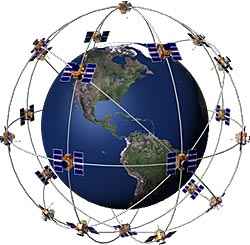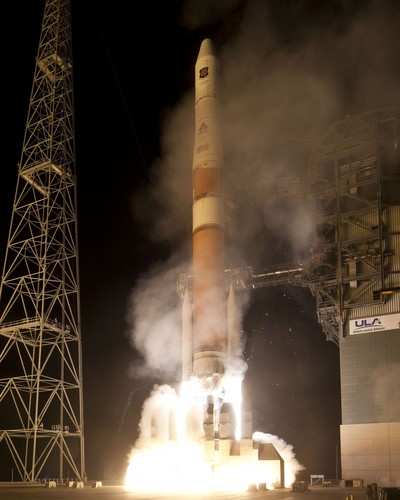Mon, May 31, 2010
GPS IIF-1 Satellite Sends 1st Signals from Space
 The first on-orbit signals from the new GPS IIF-1 satellite,
the inaugural spacecraft in a 12-satellite constellation that the
company is building for the U.S. Air Force have been received. The
signals indicate that the spacecraft bus is functioning normally
and ready to begin orbital maneuvers and operational testing.
The first on-orbit signals from the new GPS IIF-1 satellite,
the inaugural spacecraft in a 12-satellite constellation that the
company is building for the U.S. Air Force have been received. The
signals indicate that the spacecraft bus is functioning normally
and ready to begin orbital maneuvers and operational testing.
A United Launch Alliance Delta IV rocket launched the GPS IIF-1
satellite at 11 p.m. Eastern time on May 27 from Cape Canaveral Air
Force Station. At 2:33 a.m., the satellite separated from the
rocket's upper stage, and a ground station on Diego Garcia in the
Indian Ocean received the first signals from the newest member of
the Air Force's GPS satellite constellation. The Air Force 19th
Space Operations Squadron and Boeing's Mission Operations Support
Center in El Segundo, Calif., confirmed that the satellite is
healthy. GPS signals from the spacecraft payload will be turned on
for test purposes in the coming weeks.
GPS is the U.S. Department of Defense's largest satellite
constellation, with 30 spacecraft on orbit. The GPS IIF satellites
will provide more precise and powerful signals, a longer design
life, and many other benefits to nearly 1 billion civilian and
military users worldwide.
"The inaugural launch of the GPS IIF-1 is a milestone in
Boeing's 30 years of support to the Air Force that goes back to the
first days of this program," said Craig Cooning, vice president and
general manager, Boeing Space and Intelligence Systems. "The new
GPS IIF satellites bring key improvements, including a more
jam-resistant military signal, a new civil signal to enhance
commercial aviation and search-and-rescue operations, and
significantly improved signal accuracy as more of these new
satellites go into operation."
The GPS IIF-1 satellite will undergo months of on-orbit tests,
including functional testing of its payloads and end-to-end system
testing to verify operability with older GPS satellites, ground
receivers, and the ground control system.

Boeing has production of the next 11 GPS IIF satellites well
under way as it implements an innovative pulse-line manufacturing
approach that will help deliver the satellite fleet on schedule.
Adapted from Boeing aircraft and helicopter assembly lines, the
Boeing GPS IIF pulse line efficiently moves satellites under
development from one work area to the next in a steady, pulse-like
rhythm. The second GPS IIF satellite is scheduled for launch later
this year.
More News
From 2023 (YouTube Edition): "Ain’t Your Daddy’s Super Cub”—Don Wade Co-owned by Don and Ron Wade—the former of Don’s Dream Machines, a storied >[...]
Pilot-Rated Passenger Reported That The Pilot Did Not Adequately “Round Out” The Landing Flare And The Airplane Bounced And Yawed To The Right Analysis: The pilot state>[...]
Dead Reckoning Dead reckoning, as applied to flying, is the navigation of an airplane solely by means of computations based on airspeed, course, heading, wind direction, and speed,>[...]
Aero Linx: Lake Amphibian Club This website is created and sponsored by the Lake Amphibian Club, to help spread the word about these wonderful, versatile amphibians that can land j>[...]
“I am deeply honored to be sworn in as NASA administrator. NASA’s mission is as imperative and urgent as ever — to push the boundaries of human exploration, ignit>[...]
 Classic Aero-TV: In Praise of Alabamas Patriot Aircraft USA
Classic Aero-TV: In Praise of Alabamas Patriot Aircraft USA NTSB Final Report: Cirrus Design Corp SR22
NTSB Final Report: Cirrus Design Corp SR22 ANN's Daily Aero-Term (12.21.25): Dead Reckoning
ANN's Daily Aero-Term (12.21.25): Dead Reckoning ANN's Daily Aero-Linx (12.21.25)
ANN's Daily Aero-Linx (12.21.25) Aero-News: Quote of the Day (12.21.25)
Aero-News: Quote of the Day (12.21.25)




